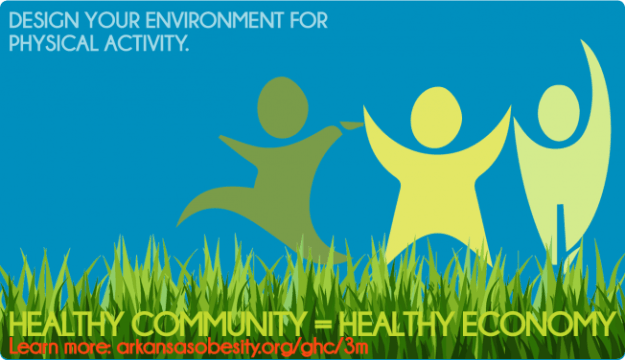
Local leaders all over Arkansas are looking at ways to protect the health and well-being of children as well as improve the appeal of our communities to developers and industry. Not only do our kids deserve opportunities to bike or walk to school, to play in safe, open spaces and to have nutritious food options – but these items are on a growing number of checklists of individuals looking for a new home and businesses looking for a new location.
Design Your Environment for Physical Activity
City leaders can improve the local environment through land use & transportation plans, zoning regulations and decisions, selection criteria for capital projects, redevelopment priorities, economic development plans, and internal personnel and facility policies.
Joint Use Agreements – Join with local school districts to develop joint use agreements that increase physical activity for children and adults during out of school time. Here’s some shorter clips from that video focusing on JUAs to improve the health of your community, City of Bryant, City of Springdale, City of Hamburg.
Active Living By Design – Active Living By Design partners with non-profits, local leaders, and funders to create healthy communities. They can help you make your streets safer, bring healthy foods to your stores, as well as build parks, playgrounds, and other active spaces for children and adults.
Centers for Disease Control Designing and Building Healthy Places – Healthy places are those designed and built to improve the quality of life for all people who live, work, worship, learn, and play within their borders — where every person is free to make choices amid a variety of healthy, available, accessible, and affordable options.
National Complete Streets Coalition – Streets are a vital part of livable, attractive communities. Everyone, regardless of age, ability, income, race, or ethnicity, ought to have safe, comfortable, and convenient access to community destinations and public places–whether walking, driving, bicycling, or taking public transportation. But too many of our streets are designed only for speeding cars or, worse, creeping traffic jams. A nationwide movement launched by the National Complete Streets Coalition in 2004, Complete Streets integrates people and place in the planning, design, construction, operation, and maintenance of our transportation networks. The Coalition promotes the development and implementation of policies and professional practices that ensure streets are safe for people of all ages and abilities, balance the needs of different modes, and support local land uses, economies, cultures, and natural environments. To date, over 700 agencies at the local, regional, and state levels have adopted Complete Streets policies.
Smart Growth America – Smart Growth America advocates for people who want to live and work in great neighborhoods. They believe smart growth solutions support thriving businesses and jobs, provide more options for how people get around and make it more affordable to live near work and the grocery store. Their coalition works with communities to fight sprawl, save money, and to make America’s neighborhoods great.
Transportation for America – T4A is helping local leaders come together and ensure that states and the federal government invest in smart, homegrown, locally-driven transportation solutions.
Walkable Communities – Walkability is the cornerstone and key to an urban area’s efficient ground transportation. Every trip begins and ends with walking. Walking remains the cheapest form of transport for all people. Construction of a walkable community provides the most affordable and equitable transportation system any community can plan, design, build and maintain. Walkable communities return urban environments to scale, pattern and mix for sustainability of resources (both natural and economic). They lead to more social interaction, physical fitness, diminished crime, and increased wellness, addressing many social and economic problems. Walkable communities are more livable built environments and lead to whole, happy, healthy lives for the people who live in them. Walkable communities attract and keep jobs, young adults, families, children and grandchildren.
Bike Friendly America – Bicycling is more than a practical, cost-effective solution to many municipal challenges. It’s an opportunity to make your community a vibrant destination for residents and visitors — a place where people don’t just live and work, but thrive. The League of American Bicyclists Bike Friendly America program provides tools and recognition for communities looking to become more bike friendly.
AARP Livable Communities Form-Based Code Fact Sheet – The use of zoning regulations began in the early 20th century in response to urban overcrowding and the intrusion of heavy industry into residential and retail areas. “Form-Based Code” explains how communities nationwide can do a much better job of land use planning and local zoning.
City Boards & Committees – Consider supporting a board or committee that will help your city prioritize a healthy built environment that benefits everyone. Here’s just a few examples of what other Arkansas cities have going on:
- Bike LR – Little Rock’s Bike Friendly Community Committee was formed by the mayor to assist the city and community as we work towards becoming a truly bike-friendly city. Along the way, we’d like to apply for, receive, and maintain a ‘Bike Friendly Community’ designation from the League of American Bicyclists.
- City of Conway’s Bicycle & Pedestrian Advisory Board – The mission of Conway’s BPAB is to work with the City to recommend ways the city can become and remain an official bike-friendly community, an official walk-friendly community, and a community with safe routes to schools.
Do you have a board or committee that should be listed here? E-mail us!



